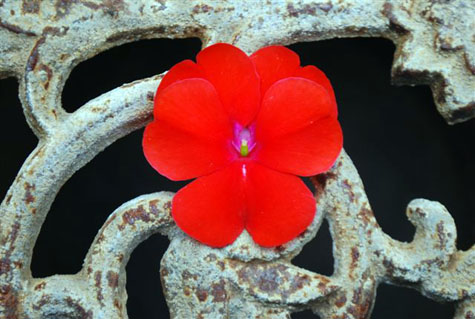
New Guinea Impatiens

Dahlia

Coleus
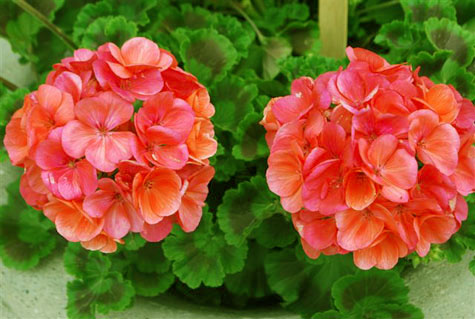
Geranium

Coleus
Deborah Silver is an accomplished and experienced landscape and garden designer whose firm first opened its doors in 1986.

New Guinea Impatiens

Dahlia

Coleus

Geranium

Coleus

Sculpture in a garden is a big topic, which I am sure will surface again and again in my writings. Defining a sculpture can be very much about the environment in which it is placed. It is my opinion that some sculpture absolutely relies on its environment, in order to earn the the honored designation-sculpture. Some sculpture I see in galleries, or museums, I would never see as sculpture-but for the gallery or museum address. Some landscape sculpture has been documented in photographs- often this sculpture is more about the moment of the photograph, than the sculpture itself. I own every book ever published about the work of Andy Goldsworthy-but many of his sculptures are ephemeral such that they are not really sculpture in a classical sense. The photographs of his works are as much art as the works themselves. But his work makes me rethink my definitions-this is a good thing to come from looking at art. I buy books regularly, and I read a lot. Its exciting to see contemporary garden sculpture-what a departure it is from classical sculpture. As I am willing to be surprised, I try to temper my sense of sculpture with a big dose of what I see, and what I am asked to do. This seems to work.
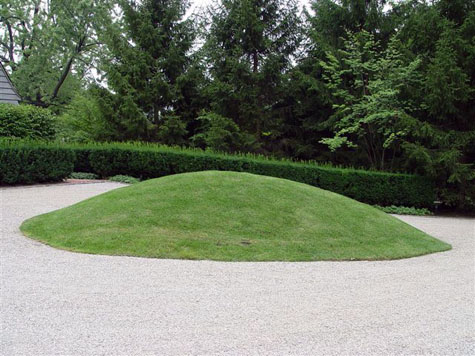
Earth sculptures have a huge history; what gardener does not know something about crop circles? What 20th century landscape designer has not given serious thought to sculptures of earth, covered in some living skin? What landscape designer, since the day that someone thought to design landscapes, doesn’t see when the landscape transcends horticulture and becomes sculpture? What gardener has not been interested in Stonehenge, and every Stonehedge counterpart documented world wide? I am not a first rate scholar on the history of garden sculpture-I am just a somewhat educated landscape designer with a big interest in garden sculpture.
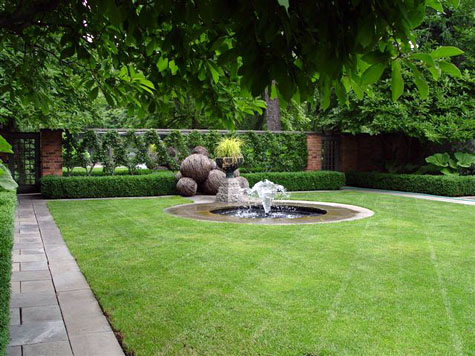
I am strictly a supporting cast, where the sculpture of my clients is concerned. I look at what they buy, and if I am lucky, they will pile things up, move things around-and talk about what moves them.
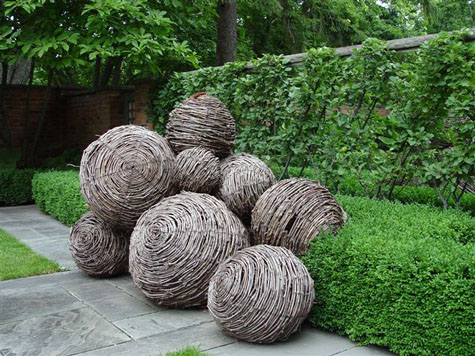
Contrary to the garden sculpture placed in Europe ever since the formal garden got its name, some sculptures are ephemeral, moveable-here today-elsewhere tomorrow. These Belgian hazelwood spheres, piled up into a boxwood hedge-who does not appreciate the gesture?
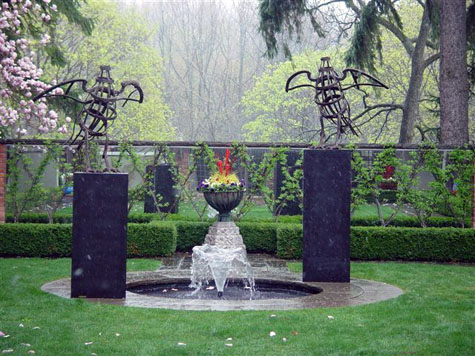
These birds once graced the roof of the Palais Royale in Paris. This would be the better part of two centuries ago. What remains of them is their wrought iron armatures, and their hand-wrought feet. This pair of ancient birds are the most spectacular sculptures I have ever seen. They have such incredible presence, though little remains of their original shape. They are so powerful in their shape and their bearing , though little of their ornament remains. What landscape would do justice to them?
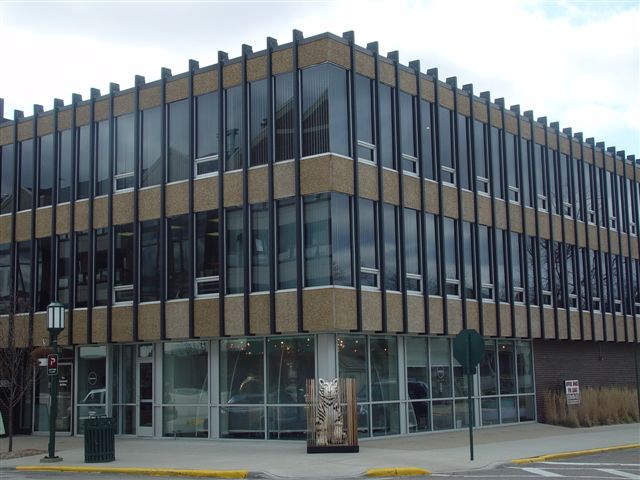
I love sculpture in a garden. Plants in a landscape, beautifully grown, can evoke awe, pleasure and respect for the beauty of nature. But like no other element of a landscape , sculpture is a product of human intelligence, imagination, and emotion, in a physical form. This sculpture I made for a community fundraiser; each participant was given a fiberglas tiger as a starting point for a sculpture, which would then be auctioned. I looked at the building-its color and its form, for an idea that would help me place it in that particular landscape. 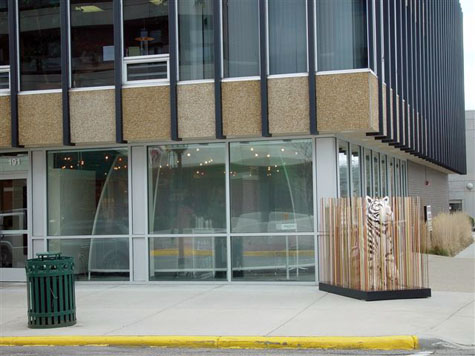
My tiger is camouflaged in varying heights of tall, grass-like, enameled steel rods. It looks right at home sitting in that ocean of steel and concrete-or does it? There is the additional suggestion that an urban landscape can imprison, or send running for shelter, all manner of living things-not just tigers. This is my imaginative construct, not a process of nature.
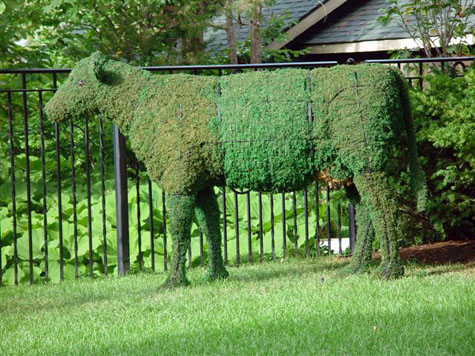
Thus I try to design spaces for sculpture that augment gracefully whatever feeling they elicit from me. I may design a small perennial meadow for a client who remembers growing up in a rural area, and has good memories of their relationship to that landscape-but one small sculpture may have the power to conjure that time , and imbue the landscape around it with that memory. I always ask clients what resonated with them, what precipitated their choice of sculpture. This helps to design the space for them in a way that has emotional meaning-not just horticultural meaning.
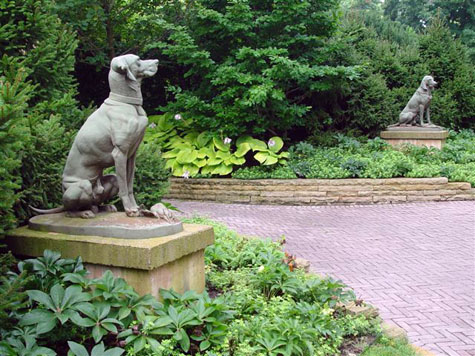
This beautiful pair of 19th century iron bloodhounds, cast by Alfred Jacquemart for Barbezat & Cie at the Val D’Osne foundry in France, circa 1865, are regal and elegant in their own right. The landscape designed for them is is tall, and thickly planted; the property is screened from any view, save straight up the drive. This pair stands watch at the driveway entrance; they speak to the emotional issues of refuge, privacy, and the safety of home.
The table and chairs reminiscent of gingko leaves and steel twigs and vines go far beyond utility to sculpture. Sculpted of steel, concrete and mortar, this is not just a place to sit. The viewer can imagine who might sit there, and for what reason. A crisply and simply designed landscape , with a beautiful shape of lawn, gives space to a sculpture that lets us see the world through the eyes of that artist. A table for 2, waiting for company and conversation-that’s a good description of of sculpture in a garden.

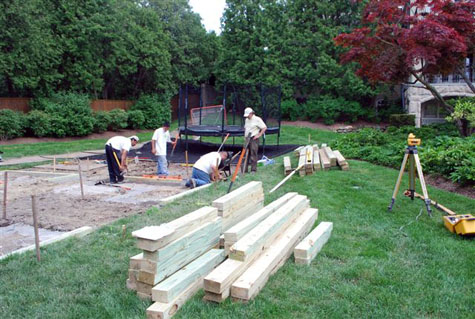

I am late getting to the posting today-but I did manage to get planted all 32 giant pots for the City of Birmingham. Not that my crew isn’t eminently capable of this; I am always the lame one. This year I was determined to get every pot designed, transfer that design to a piece of paper in a readable form, assemble the material, and help load. Diana and her crew take care of the rest-I did not hear from her all day. Except at 4:30-her call that everything was done. She rocks. 
This vegetable garden, with a must complete date of June 6 is coming to a construction close . We have set the 14 foot tall beech arbor, underplanted it with asparagus, (put your imagination to work about how this will look in 3 years) built the vegetable boxes, and planted the columnar apple trees from Henry Luthardt. We installed drain tile, excavated soil and installed a decomposed granite surface to walk on. How I love the sound of gravel underfoot-and this 3/8 inch and down decomposed granite compacts hard enough to take a pair of Jimmie Choo 4 inch heels without the slightest dent. In the center, an herb theatre, with steel arches reminiscent of the Roman aquaducts. Tomorrow we plant the “wild at heart” apple espaliers, install the tomato cage/obelisks, and the tomatoes, plant the vegetables, rhubarb and strawberries. We need to doll up the grade in one spot, and resod. Today, the irrigation is getting installed. Copper, with spray risers. I like the look of overhead irrigation-its beautiful. I hate drip irrigation-it clogs, and malfunctions-you can’t spot any malfunction until things are crisp. And the water is never where you want it, with drip. Drip irrigation is a great idea that the reality is not where it should be. For now, I like water when I can see it. And I like how this garden is at the fun tune-up stage. My most favorite part of a job coming to a close, is washing off the walks, and terraces. Washing off the digging, the sweating, the agonizing over this choice or that. This feeling lasts the better part of 3 seconds, as every gardener knows no garden is ever finished. It is either going backwards or going forwards. No neutral. 
Deborah Silver is a landscape and garden designer whose firm, Deborah Silver and Co Inc, opened its doors in 1986. She opened Detroit Garden Works, a retail store devoted to fine and unusual garden ornament and specialty plants, in 1996. In 2004, she opened the Branch studio, a subsidiary of the landscape company which designs and manufactures garden ornament in a variety of media. Though her formal education is in English literature and biology, she worked as a fine artist in watercolor and pastel from 1972-1983. A job in a nursery, to help support herself as an artist in the early 80’s evolved into a career in landscape and garden design. Her landscape design and installation projects combine a thorough knowledge of horticulture with an artist’s eye for design. Her three companies provide a wide range of products and services to the serious gardener. She has been writing this journal style blog since April of 2009.
Copyright © 2024 · Deborah Silver & Co. · Detroit Garden Works